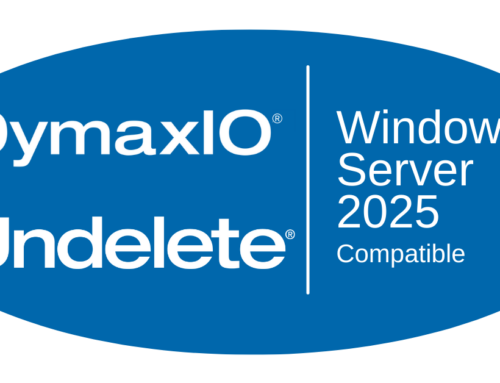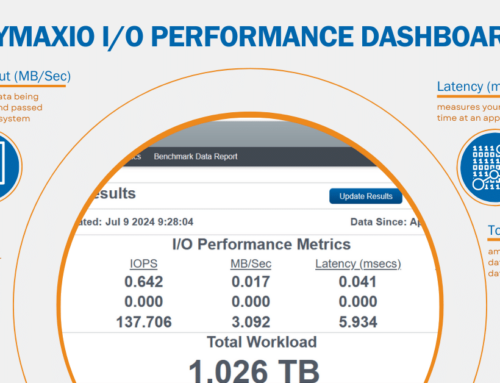As more of our customers migrate their on-premises Windows systems to the cloud (IaaS – Infrastructure As a Service), the question arises: Is DymaxIO still necessary? Many customers recognize the need, but some assume it’s no longer relevant. This assumption is false.
Cloud-based Windows systems encounter the same I/O bottlenecks, I/O tax, I/O Blender effect, and fragmentation issues as their in-house physical and virtual systems. Despite the shift in infrastructure, Windows’ inherent write inefficiencies persist, dampening overall performance. Whether running Windows in the cloud, on hyperconverged systems, or all-flash storage, Windows behavior remains consistent, impacting performance.
Even in the cloud, files are always broken down into much smaller parts than they need to be, leading to excessive I/O operations that consume valuable IOPS, degrade throughput, and slow down operations. Unfortunately, moving to the cloud doesn’t alleviate these Windows-related challenges.
Why DymaxIO is Essential in the Cloud
Fortunately, DymaxIO continues to deliver performance benefits on cloud systems, addressing these issues and maintaining expected performance levels. In fact, DymaxIO offers additional advantages specifically tailored to cloud environments, particularly in cost optimization. Cloud providers like AWS and Azure typically charge based on data processing, storage, and I/O operations. DymaxIO reduces the volume of I/O operations, which can translate into significant cost savings.
Key Benefits of DymaxIO in Cloud Environments:
- Enhanced Performance on Standard Tiers: DymaxIO improves performance on lower-cost, standard cloud tiers, enabling you to avoid paying for premium, high-performance storage or compute services. This delivers cost savings while maintaining high performance.
- Reduced Cloud Service Costs: By reducing I/O operations, DymaxIO cuts the number of read/write transactions, directly lowering data processing, storage, and I/O usage costs in pay-per-use cloud models like AWS and Azure.
- Optimized Resource Allocation: DymaxIO minimizes the load on virtual machines, allowing you to use smaller, less expensive cloud instances without compromising performance. This avoids the need for high-performance and costly instances.
- Decreased Storage Costs: By reducing the frequency of read/write operations, DymaxIO lowers the demand on cloud storage services like AWS EBS or Azure Disks. This allows you to stick with more affordable storage options while maintaining high performance.
- Lower Data Egress Fees: DymaxIO reduces the amount of data transferred between regions or services, minimizing data egress fees that cloud providers charge when moving data across regions or outside their infrastructure.
- No Infrastructure Management: In managed environments like AWS and Azure, where physical infrastructure is handled by the provider, DymaxIO still optimizes storage and I/O, allowing for better performance and cost savings without worrying about hardware.
- Pay for What You Use: DymaxIO ensures that your cloud resources are efficiently used, preventing over-provisioning and allowing you to pay only for the resources you truly need. This helps avoid unnecessary costs.
Why Cloud Transitions Don’t Eliminate I/O Challenges
In some cases, DymaxIO on cloud systems can offer an additional benefit: lower I/O costs. For cloud customers, especially those on pay-per-use models, reducing I/O operations is not only a performance improvement but also a way to manage expenses. DymaxIO’s IntelliMemory Read caching feature reduces read activity from storage devices, lowering storage I/O activity and potentially reducing costs.
Additionally, customers with current DymaxIO subscriptions can transfer active licenses from on-premise systems to cloud servers, maximizing investment efficiency and ensuring seamless performance across environments.
Summary
In short, DymaxIO optimizes cloud environments by reducing I/O costs, enhancing performance on standard cloud tiers, and minimizing resource usage while lowering storage and data transfer fees. Whether in the cloud or on physical infrastructure, DymaxIO’s flexibility ensures that your IT environment runs efficiently without the need for expensive, high-performance resources.
For assistance with license transfers or further information, please reach out to customer support or your account manager. With its ability to optimize performance across environments, DymaxIO remains essential for both on-premise and cloud systems.
Resources:
Windows is still Windows Whether in the Cloud, on Hyperconverged or All-flash https://condusiv.com/windows-is-still-windows-whether-in-the-cloud-on-hyperconverged-or-all-flash/
Solving the I/O Blender Effect with Software-Based Caching https://condusiv.com/solving-the-io-blender-effect-with-software-based-caching/
IntelliWrite Makes Writes Happen Far More Intelligently https://condusiv.com/intelliwrite-behind-the-magic-curtain/
Videos:
The Impact of the I/O Blender Effect on Windows Performance https://condusiv.com/videos/videos-the-impact-of-the-i-o-blender-effect-on-windows-performance/
The I/O Request Path: Why Unnecessary I/Os are Created https://condusiv.com/videos/videos-the-io-request-path-why-unnecessary-ios-are-created/
Two I/O Taxes in Virtualized Environments https://condusiv.com/videos/two-io-taxes-in-virtual-environments/
Published on Apr 11, 2024
Updated Oct 22, 2024






Leave A Comment
You must be logged in to post a comment.